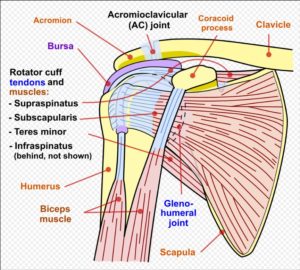Last week we exercised your infraspinatus, after loosening your tight subscapularis the week before. This week let’s talk about strengthening your weak supraspinatus muscles.
Wait, wut? What the hell is a “supraspinatus?”

It’s one of the rotator cuff muscles, it lies above the shoulder blade and the infraspinatus, and is one of the muscles which stabilize the shoulder. In addition to shoulder stabilization, it also responsible for abduction; moving the arm out to the side, and up toward the ear.
There are two basic exercises for strengthening the supraspinatus; the empty can exercise, and the full can exercise. We’ll do them in reverse order.
The full can exercise:
- Imagine you’re holding a full can of pop (that’s “soda” for you philistines out there)
- Raise your arm out to the side, until your hand is at shoulder height
- Perform 10 repetitions
Key to the exercise is maintaining the vertical position of your hand, i.e. not spilling your pop. Also key is not allowing the hand to move forward or back out of its plane of motion. You can do the exercise with your back to a wall in order to help maintain motion in the plane.
The empty can exercise is the exact same as the full can exercise, except you imagine holding your pop can exactly upside down, emptying it. It is somewhat controversial in orthopaedic health care because the downward rotated position of the hand can cause impingement of the supraspinatus tendon. That is, the tendon can get pinched between the acromion and the ball of the humerus.
If in doubt, don’t take the risk, and do the full can exercise.
For what it’s worth, that is what I do. My shoulder, back and posture problems are chronic and multi-decadal. I have far fewer years of decent posture than I do of poor posture, and anything that risks pain, which could set back my posture work and back pain recovery, is something I avoid.
I’ll repeat that.
I only do the full can exercise.
Of course, being a bit of a maniac, I also don’t do it empty handed. I use 2-1/2 or 5 lb weights. Do this at your own risk, and discomfort, because make no mistake, adding a load to this exercise will cause discomfort.
